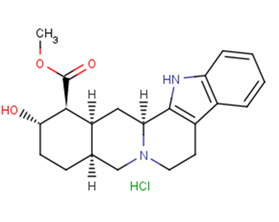 Home -
Products -
Cytoskeleton/Cell Adhesion Molecules -
Microtubule/Tubulin -
Rauwolscine hydrochloride
Home -
Products -
Cytoskeleton/Cell Adhesion Molecules -
Microtubule/Tubulin -
Rauwolscine hydrochloride

Rauwolscine hydrochloride
CAS No. 6211-32-1
Rauwolscine hydrochloride( α-Yohimbine hydrochloride | Isoyohimbine hydrochloride )
Catalog No. M18915 CAS No. 6211-32-1
Rauwolscine, a natural alkaloid, is a specific and reversible α2-adrenergic receptor antagonist (Ki: 12 nM).
Purity : >98% (HPLC)
 COA
COA
 Datasheet
Datasheet
 HNMR
HNMR
 HPLC
HPLC
 MSDS
MSDS
 Handing Instructions
Handing Instructions
| Size | Price / USD | Stock | Quantity |
| 50MG | 45 | In Stock |


|
| 100MG | Get Quote | In Stock |


|
| 200MG | Get Quote | In Stock |


|
| 500MG | Get Quote | In Stock |


|
| 1G | Get Quote | In Stock |


|
Biological Information
-
Product NameRauwolscine hydrochloride
-
NoteResearch use only, not for human use.
-
Brief DescriptionRauwolscine, a natural alkaloid, is a specific and reversible α2-adrenergic receptor antagonist (Ki: 12 nM).
-
DescriptionRauwolscine, a natural alkaloid, is a specific and reversible α2-adrenergic receptor antagonist (Ki: 12 nM). It is a stereoisomer of yohimbine, which potently antagonizes both α1- and α2-adrenergic receptors. Rauwolscine also acts as a receptor antagonist at the serotonin 5-HT2B receptor (Ki: 14.3 nM) and as a weak partial agonist at 5-HT1A (IC50: 1.3 μM). The α2-adrenergic receptor has diverse physiological functions and antagonists like rauwolscine have numerous applications, including the modulation of mood and behavior.(In Vitro):[3H]Rauwolscine binding to α2 adrenergic receptor is reversible, stcreospccific, and saturable. [3H]Rauwolscine specifically labels both the high and low affinity states of the α2 adrenergic receptor in brain membranes. [3H]Rauwolscine also behaves as a 5-HT1A receptor agonist and this conclusion is compatible with earlier functional studies, indicating that rauwolscine (as well as yohimbine) has agonistic properties at the level of 5-HT autoreceptors. When using [3H]5-HT as a radioligand, rauwolscine is determined to have relatively high affinity for the human receptor (Ki human=14.3 nM, Ki rat=35.8 nM). Saturation studies shows that the affinity of [3H]Rauwolscine is similar in mouse, rat, rabbit, dog (2.33-3.03 nM) except man where it is significantly higher (0.98 nM) .
-
In Vitro[3H]Rauwolscine binding to α2 adrenergic receptor is reversible, stcreospccific, and saturable. [3H]Rauwolscine specifically labels both the high and low affinity states of the α2 adrenergic receptor in brain membranes. [3H]Rauwolscine also behaves as a 5-HT1A receptor agonist and this conclusion is compatible with earlier functional studies, indicating that rauwolscine (as well as yohimbine) has agonistic properties at the level of 5-HT autoreceptors. When using [3H]5-HT as a radioligand, rauwolscine is determined to have relatively high affinity for the human receptor (Ki human=14.3 nM, Ki rat=35.8 nM). Saturation studies shows that the affinity of [3H]Rauwolscine is similar in mouse, rat, rabbit, dog (2.33-3.03 nM) except man where it is significantly higher (0.98 nM) .
-
In Vivo——
-
Synonymsα-Yohimbine hydrochloride | Isoyohimbine hydrochloride
-
PathwayCytoskeleton/Cell Adhesion Molecules
-
TargetMicrotubule/Tubulin
-
Recptorα2 adrenergic receptor
-
Research Area——
-
Indication——
Chemical Information
-
CAS Number6211-32-1
-
Formula Weight390.9
-
Molecular FormulaC21H27ClN2O3
-
Purity>98% (HPLC)
-
SolubilityDMSO : 6 mg/mL 15.35 mM; H2O : 5 mg/mL 12.79 mM
-
SMILESCl.[H][C@]12CC[C@H](O)[C@@H](C(=O)OC)[C@@]1([H])C[C@]1([H])N(CCc3c1[nH]c1ccccc31)C2
-
Chemical Name——
Shipping & Storage Information
-
Storage(-20℃)
-
ShippingWith Ice Pack
-
Stability≥ 2 years
Reference
1.Perry B D, U'Prichard D C. [3H] Rauwolscine (α-yohimbine): a specific antagonist radioligand for brain α2-adrenergic receptors[J]. European journal of pharmacology, 1981, 76(4): 461-464.
molnova catalog



related products
-
KIF18A-IN-2
KIF18A-IN-2 is an inhibitor of mitotic kinesin Kif18A with IC50 of 28 nM and can be used in studies about chromosomal instability-associated vulnerabilities.
-
ABT-751
ABT-751 (E-7010) is an orally active antimitotic agent that inhibits tubulin polymerization.
-
Taccalonolide B
Taccalonolide B is effective in vitro against cell lines that overexpress P-glycoprotein (Pgp) and multidrug-resistance protein (MRP7).?Taccalonolide B inhibits growth of SK-OV-3 cells with an IC50 of 208 nM.The structures were elucidated using a combination of spectroscopic methods, including 1D and 2D NMR and HR-ESI-MS.



 Cart
Cart
 sales@molnova.com
sales@molnova.com

